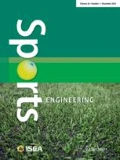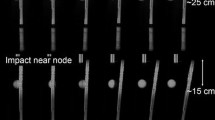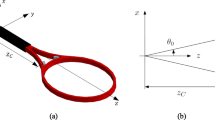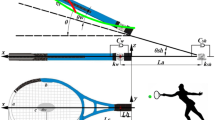Abstract
Modern tennis rackets are manufactured from composite materials with high stiffness-to-weight ratios. In this paper, a finite element (FE) model was constructed to simulate an impact of a tennis ball on a freely suspended racket. The FE model was in good agreement with experimental data collected in a laboratory. The model showed racket stiffness to have no influence on the rebound characteristics of the ball, when simulating oblique spinning impacts at the geometric stringbed centre. The rebound velocity and topspin of the ball increased with the resultant impact velocity. It is likely that the maximum speed at which a player can swing a racket will increase as the moment of inertia (swingweight) decreases. Therefore, a player has the capacity to hit the ball faster, and with more topspin, when using a racket with a low swingweight.














Similar content being viewed by others
References
Haines R (1993) The sporting use of polymers, vol 22. Shell petrochemicals
ITF TECHNICAL DEPARTMENT (2009) International Tennis Federation (online). Accessed 1 May 2009. http://www.itftennis.com/technical
Lammer H, Kotze J (2003) Materials and tennis rackets. In: Jenkins M (ed) Materials in sports equipment. Woodhead Publishing Limited, Cambridge, pp 222–248
Brody H (1997) The physics of tennis 3: the ball–racket interaction. Am J Phys 65(10):981–987
Brody H (1997) The influence of racquet technology on tennis strokes. Tennis Pro (1):10–11
Haake S, Allen T, Choppin S, Goodwill S (2007) The evolution of the tennis racket and its effect on serve speed. In: Tennis science and technology 3, vol 1. International Tennis Federation, London, pp 257–271
Allen T, Goodwill S, Haake S (2008) Experimental validation of a FE model of a head-clamped tennis racket. ANSYS UK Users Conference, Oxford
Allen T, Goodwill S, Haake S (2008) Experimental validation of a finite-element model of a tennis ball for different temperatures. The engineering of sport 7, vol 1. Springer, Biarritz, pp 125–133
Allen T, Goodwill S, Haake S (2008) Experimental validation of a finite-element model of a tennis racket stringbed. The engineering of sport 7, vol 1. Springer, Biarritz, pp 115–123
Allen T, Goodwill S, Haake S (2007) Experimental validation of a tennis ball finite-element model. In: Tennis science and technology 3, vol 1. International Tennis Federation, London, pp 21–30
Goodwill SR, Kirk R, Haake SJ (2005) Experimental and finite element analysis of a tennis ball impact on a rigid surface. Sports Eng 8(3):145–158
Goodwill SR, Haake SJ (2004) Ball spin generation for oblique impacts with a tennis racket. Exp Mech 44(2):195–206
Brody H (1987) Models of tennis racket impacts/(modeles d’ impacts sur raquette de tennis.). Intern J Sport Biomech 3(3):293–296
Goodwill SR, Haake SJ (2001) Spring damper model of an impact between a tennis ball and racket. Proceedings of the Institution of Mechanical Engineers. Part C. J Mech Eng Sci 215(11):1331–1341
Goodwill S, Haake S (2003) Modelling of an impact between a tennis ball and racket. In: Tennis science and technology 2, vol 1. International Tennis Federation, London, pp 79–86
Choppin S, Goodwill S, Haake S, Miller S (2008) Ball and racket movements recorded at the 2006 Wimbledon qualifying tournament. The engineering of sport 7, vol 1. Springer, Biarritz, pp 563–569
Goodwill SR, Haake SJ (2004) Effect of string tension on the impact between a tennis ball and racket. In: The engineering of sport 5. Davis, California, pp 3–9
Goodwill S, Capel-Davies J, Haake S, Miller S (2007) Ball spin generation of elite players during match play. In: Tennis science and technology 3, vol 1. International Tennis Federation, London, pp 349–356
Kelley J, Goodwill S, Capel-Davies J, Haake S (2008) Ball spin generation at the 2007 Wimbledon qualifying tournament. The engineering of sport 7, vol 1. Springer, Biarritz, pp 571–578
Mase T, Kersten AM (2004) Experimental evaluation of a 3-D hyperelastic, rate-dependent golf ball constitutive model. In: The engineering of sport 5. International Sports Engineering Association, California, pp 238–244
Beisen E, Smith L (2007) Describing the plastic deformation of aluminium softball bats. Sports Eng 10(4):185–194
Peterson W, McPhee J (2008) Shape optimization of golf clubheads using finite element impact models. In: The engineering of sport 7, vol 1. Springer, France, pp 465–473
Goodwill SR (2002) The dynamics of tennis ball impacts on tennis rackets. Ph.D. thesis, The University of Sheffield
Walker P (1991) Chambers science and technology dictionary. W & R Chamber Limited, Edinburgh
Cross R (2000) Effects of friction between the ball and strings in tennis. Sports Eng 3(1):85–97
Allen TB (2009) Finite element model of a tennis ball impact with a racket. Ph.D. thesis, Sheffield Hallam University
Choppin SB (2008) Modelling of tennis racket impacts in 3D using elite players. Ph.D. thesis, The University of Sheffield
Bouguet J (2008) Camera calibration toolbox for matlab. http://www.vision.caltech.edu/bouguetj/calib_doc
Zhang Z (1999) Flexible camera calibration by viewing a plane from unknown orientations. In: International conference on computer vision. Corfu, Greece, pp 666–673
Kanda Y, Nagao H, Naruo T (2002) Estimation of tennis racket power using three-dimensional finite element analysis. In: The engineering of sport 4, Kyoto, Japan, pp 207–214
Cross R (2003) Oblique impact of a tennis ball on the strings of a tennis racket. Sports Eng 6(1):235–254
Mitchell SR, Jones R, King M (2000) Head speed vs. racket inertia in the tennis serve. Sports Eng 3(2):99–110
Miller S (2006) Modern tennis rackets, balls and surfaces. Br J Sports Med 40:401–405
Acknowledgments
The authors would like to thank Prince for sponsoring the project. They would also like to thank Terry Senior, Simon Choppin and John Kelley.
Author information
Authors and Affiliations
Corresponding author
Rights and permissions
About this article
Cite this article
Allen, T., Haake, S. & Goodwill, S. Comparison of a finite element model of a tennis racket to experimental data. Sports Eng 12, 87–98 (2009). https://doi.org/10.1007/s12283-009-0032-5
Published:
Issue Date:
DOI: https://doi.org/10.1007/s12283-009-0032-5




